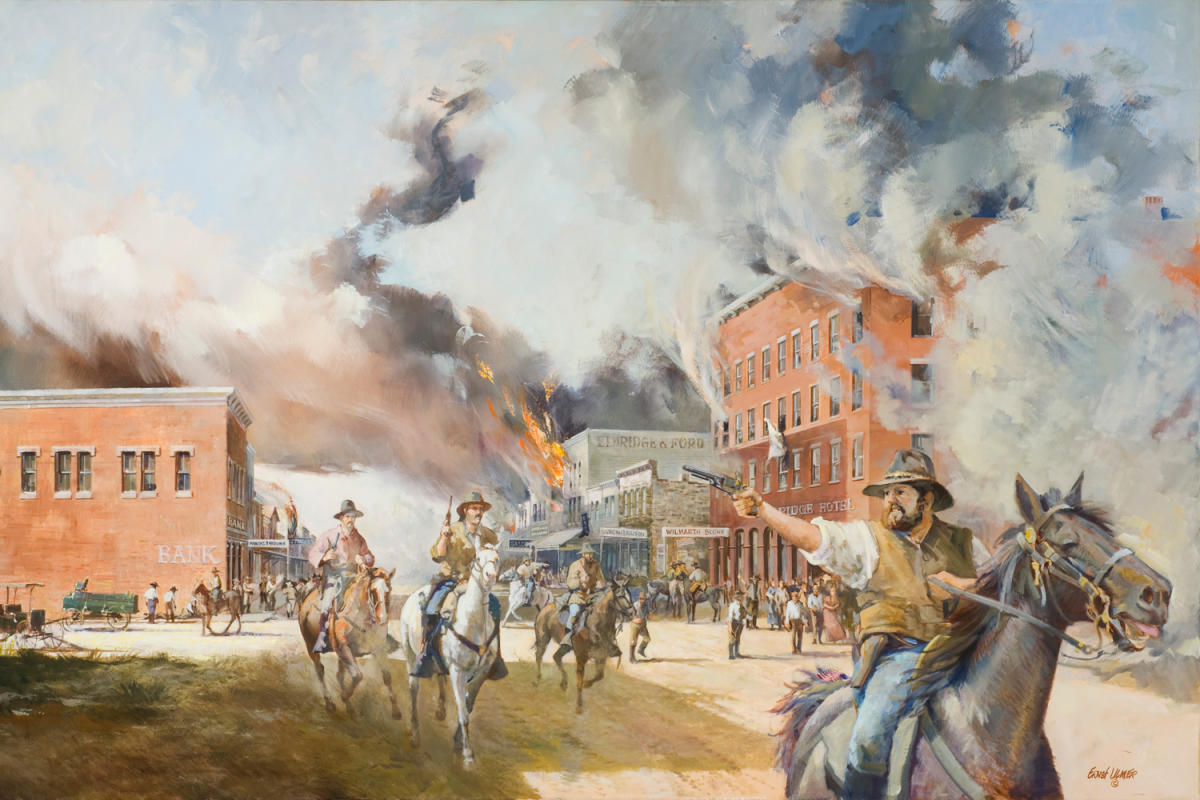 Painting "Blood-Stained Dawn" by Ernst Elmer/Courtesy Watkins Museum of History
Painting "Blood-Stained Dawn" by Ernst Elmer/Courtesy Watkins Museum of History
The Kansas town was a symbol of freedom and haven for those who fought slavery … so 160 years ago, Confederate sympathizers rode into Lawrence to kill its men and burn its homes
It was the evening of Thursday, August 20, 1863. Despite the bloody war raging along the Kansas-Missouri border, few places in Kansas were booming like Lawrence. Schoolteacher Edward Fitch and his wife, Sarah, strolled along downtown Massachusetts Street, the city’s commercial and social heart. Sarah would recall the young couple admiring “all the new buildings & all the projected improvements—How bright—how glowing with happiness and prosperity seemed the future. How little we dreamed of the horror which even then was hovering over us ….” That moment, hundreds of heavily armed men were riding for Lawrence. Their imminent assault—known as “Quantrill’s Raid,” or the “Lawrence Massacre”—would devastate the Fitches’ community for a short period, but mark it for all time.
Founded in 1854 as a “free state fortress,” Lawrence rallied to the Union cause when the Civil War began seven years later. The town became a haven for escaped enslaved people, and many local men left to fight, either in the conventional war farther east or the savage, ever-escalating guerrilla struggle with Confederate bushwhackers and their allies in Missouri, who viewed and hated Lawrence as a bastion of abolitionists and marauding jayhawkers.
Lawrence lived under the threat of bushwhacker raids. Several alarms had proved unfounded, and by August 20, 1863, the city’s 3,000 residents spoke confidently of railroad construction and other developments—not of an impending attack.
A force led by the famed Captain William C. Quantrill would shatter that confidence. Emerging from their Missouri hideouts, Quantrill and some 450 followers launched a daring mission: bent on looting and destroying Lawrence, they rode west over 100 miles through Union-occupied territory. Quantrill had lived and taught school in Lawrence for up to two years. He knew the city well and counted among his intended targets prominent individuals, especially leading jayhawker James Henry Lane.
On Friday, August 21, just before dawn lit the Kansas sky, Lawrencians awoke to gunshots and hoofbeats. Quantrill and his men had arrived.
The surprise was complete, the city totally undefended.
Reaching South Park—a gathering spot for the community—Quantrill and his main body rode up Massachusetts Street while smaller bands fanned out across town, shouting battle cries and shooting at any man they saw. “They flowed into every street and lane like water dashed upon a rock,” wrote local minister Richard Cordley.
George Todd, one of Quantrill’s fiercest lieutenants, led a mounted charge through a small army encampment on New Hampshire Street, killing most of the young, unarmed recruits. Just to the west, a group of Black recruits fared better. Thinking quickly, the men fled with other formerly enslaved people to either the riverbank or West Lawrence.
In town, bushwhackers began systematically robbing, killing, and burning. Edward and Sarah Fitch and their two children listened as the New Hampshire Street encampment, just behind their house, was overrun. “In five or ten minutes, fires were springing up in every direction,” Sarah remembered. A gang burst through their door, shot Edward multiple times, and set the Fitch home ablaze. Sarah would later recall that after the attackers forced her from the house without Edward’s body, she and her children “threw ourselves upon the ground—and watched the work of death and desolation go on.” By that time, Quantrill had already reached one of his main objectives: the Eldridge House. The four-story hotel was renowned as a military and commercial center. It took mere minutes for the staff and guests to surrender, whereupon the jubilant bushwhackers forced everyone outside, seized their valuables, and set fire to the building. As flames reached chemicals stored in the first-floor pharmacy, explosions added to the fearful din.
Quantrill was not entirely absent a sense of honor. When several hotel residents identified him as the shadowy young man who had lived in their city a few years earlier, Quantrill placed a guard over the crowd to ensure their safety.
This gallantry was not extended to all. Eyewitnesses around Lawrence noted that Quantrill’s men targeted African Americans with “special malignity.” As the Eldridge burned, the raiders refused to allow the 24-day-old son of Black employee Peter Jones and his wife, Mary, to be rescued; the infant became the raiders’ youngest victim.
In other instances, some raiders declined to shoot men and even helped women remove possessions before torching their homes. Women, indeed, became the heroes of the day. Shielded from being killed by the mores of the time, Lawrence women helped male relatives escape, hid valuables, and in some cases boldly followed raiders around their homes, putting out fires they set. The most famous instances of courage belonged to Kate Riggs and Elizabeth Fisher, who both confronted bushwhackers and saved their husbands’ lives.
Countless people hid in cornfields, ravines, and other organic barriers to evade attackers. At least one man found grimmer concealment. As raiders ordered out male residents of the Dix home and the Johnson House, neighboring structures on Vermont Street, George E. Young escaped execution by crawling into a drain hole in the cellar of an unfinished building on Massachusetts Street and pulling two dead bodies over himself. Raiders came through but missed Young, and the new building’s green lumber didn’t burn easily—allowing Young to survive.
Also fortunate was James Lane. In the early moments of the attack, a Black man fleeing through West Lawrence stopped at the Lanes’ impressive, newly built mansion to warn them of danger. Realizing he must be a prime target, Lane escaped from his home just before raiders burned it down. Barely dressed and seeking revenge, Lane would marshal a small force of survivors to join in pursuing Quantrill after the raid.
Nearly four hours after the attack began, Quantrill’s scouts spotted Union cavalry approaching in the distance. The captain ordered his men to gather their loot, mount fresh horses, and ride south out of town. Stragglers terrorized townspeople for some time, and one of them—the drunken, brutal Larkin Skaggs—paid for it with his life. When Skaggs became separated from his comrades, vengeful survivors shot him dead, dragged his corpse through the streets, and burned it. Reportedly, it was a shot from 16-year-old William Speer, who lost two brothers that day, that brought Skaggs down.
Despite skirmishing with Union pursuers and ravaging farmsteads along the way, nearly all the bushwhackers made it back to Missouri. They left devastation in their wake.
In Lawrence, the raiders had killed perhaps 150 to 180 men and boys; the exact count will never be known, both because numerous strangers had been stopping in town and because some bodies were lost in the fires. At least 85 women were widowed and 245 children left fatherless.
Only a handful of businesses still stood and over 100 houses around the city were damaged or leveled. In addition to the lives and property destroyed, many families lost all their savings.
A traveler who arrived in Lawrence the night of the raid reported that “we could distinguish the line of Quantrill’s retreat for many miles, by the light of burning houses.” Another survivor noted that the “whole length of Massachusetts Street was a mass of ruins.”
For newly widowed Sarah Fitch and others like her, Lawrence was now the “City of Sorrow.” The dead lay everywhere. It took a week to find and bury all of them; compounding the horror, many bodies were so badly burned they fell apart in movers’ hands. Lawrencians drew strength from their own determination as well as the food, building materials, and monetary aid that poured in from supporters in Kansas and across the United States. Residents also revitalized their local militia and, with the help of fortifications and a garrison of soldiers, ensured there would be no repeat of August 21, 1863.
As Lawrence began recovering, Kansans demanded retaliation for the massacre. Union forces delivered it through harsh crackdowns on bushwhackers and civilians in western Missouri. Guerrilla warfare continued for nearly two more years before the threat posed by Quantrill and other bushwhackers was eliminated. Yet the Lawrence Massacre, the retribution Kansans exacted, and other flashpoints in the border war spawned decades of grief and bitterness on both sides.
Reverend Cordley, who lost his own home in the raid, correctly predicted, “One year will almost obliterate the real marks of Quantrill’s steps.” By late 1864, Lawrence was more prosperous than ever before. But emotional and symbolic marks have been longer-lasting. Most important of all, perhaps, has been the legacy of resilience that 21st-century Lawrencians still carry from their city’s most tragic day.




